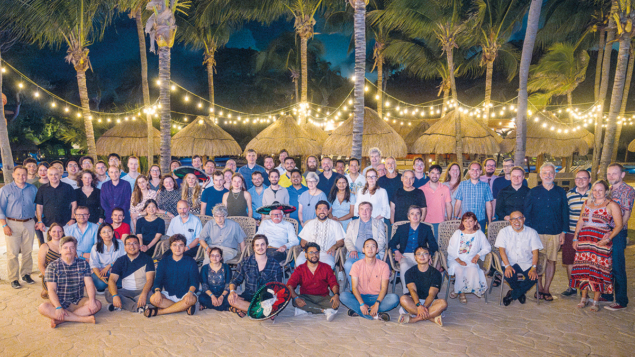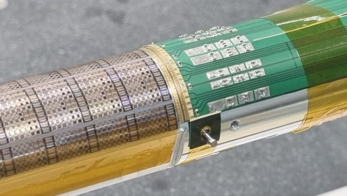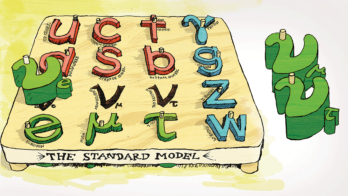
Ultra-peripheral collisions (UPCs) involving heavy ions and protons represent the energy frontier for photon-induced reactions. These high-energy photons can be used to study unique features of quarks and gluons inside nuclei, and can probe electromagnetic and electroweak interactions without the usual backgrounds associated with quantum-chromodynamic processes. The first edition of the international workshop on this subject took place from 10 to 15 December 2023 in Playa del Carmen, Mexico, bringing together about 90 participants, more than a third of whom were early-career researchers. This is the first time that the international UPC community has gathered together, establishing a new international conference series on this active and expanding area of research.
The conference highlighted the impressive progress and diversity of UPC physics, which goes far beyond the initial studies of exclusive pro-cesses. UPC23 covered the latest results from experiments at RHIC and the LHC, and prospects for the future Electron-Ion Collider (EIC) at Brookhaven National Laboratory. Discussions delved into the intricacies of inelastic photo-nuclear events, including the exciting programme of open charm that is yet to be explored, and examined how UPCs serve as a novel lens for investigating the quark–gluon plasma and other final-state nuclear effects. Lots of attention was devoted to the physics of low-x parton densities – a fundamental aspect of protons and nuclei that photons can probe in a unique way.
Enriched understanding
Among the conference’s theoretical highlights, Farid Salazar (UCLA) showed how vector–meson photoproduction could be a powerful method to detect gluon saturation across different collision systems, from proton–nucleus to electron–nucleus to UPCs. Zaki Panjsheeri (Virginia) put forth innovative ideas to study double-parton correlations, linking UPC vector–meson studies to generalised parton distributions, enhancing our understanding of the proton’s structure. Ashik Ikbal (Kent State), meanwhile, introduced exciting proposals to investigate quantum entanglement through exclusive J/ψ photoproduction at RHIC.
The conference also provided a platform for discussing the active exploration of light-by-light scattering and two-photon processes for probing fundamental physics and searches for axion-like particles, and for putting constraints on the anomalous magnetic moment of the tau lepton (see CMS closes in on tau g–2).
Energy exploration
Physicists at the LHC have effectively repurposed the world’s most powerful particle accelerator into a high-energy photon collider. This innovative approach, traditionally the domain of electron beams in colliders like LEP and HERA, and anticipated at the EIC, allows the LHC to explore photon-induced interactions at energies never before achieved. David Grund (Czech Technical University in Prague), Georgios Krintiras (Kansas) and Cesar Luiz Da Silva (Los Alamos) shared the latest LHC findings on the energy dependence of UPC J/ψ events. These results are crucial for understanding the onset of gluon saturation – a state where gluons become so dense reaching saturation, the dynamical equilibrium where the emission and recombination occurs. However, the data also align with the nuclear phenomenon known as gluon shadowing, which arises from multiple-scattering processes. David Tlusty (Creighton) presented the latest findings from the STAR Collaboration, which has recently expanded its UPC programme, complementing the energy exploration at the LHC. Klaudia Maj (AGH University of Krakow) presented the latest results on two-photon interactions and photonuclear jets from the ATLAS collaboration, including measurements that may be probing the quark-gluon plasma.
Delegates discussed the future opportunities for UPC physics with the large integrated luminosity expected for Runs 3 and 4 at the LHC
Carlos Bertulani (Texas A&M) paid tribute to Gerhard Baur, who passed away on June 16 last year. Bertulani and Baur co-authored “Electromagnetic processes in relativistic heavy ion collisions” – a seminal paper with more than 1000 citations. Bertulani invited delegates to consider the untapped potential of UPCs in the study of anti-atoms and exotic atoms.
Delegates also discussed the future opportunities for UPC physics with the large integrated luminosity expected for Run 3 and Run 4 at the LHC, with the planned detector upgrades for Run 4 such as FoCal, the recent upgrades by STAR, the sPHENIX programme and at the EIC. Delegates are expecting event selection and instrumentation close to the beam line, for example using “zero degree” calorimeters, to offer the greatest experimental opportunities in the coming years.
The next edition of the UPC conference will take place in Saariselka, Finland in June 2025.





